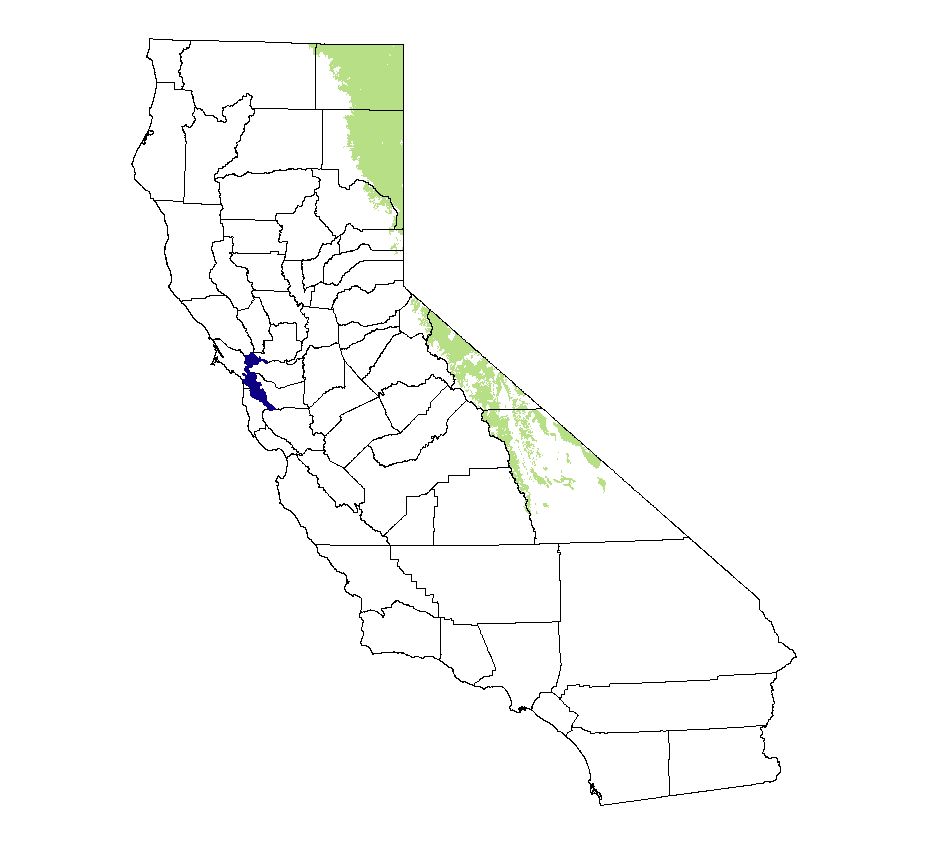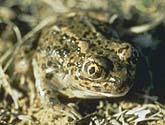
Home | About Us | Projects | Maps | Facts

Home | About Us | Projects | Maps | Facts

Great Basin Spadefoot Toad (Spea intermontana)
Description: The Great Basin Spadefoot Toad is a small rotund amphibian, with gray or olive-green coloration. The large golden-yellow eyes, with cat-like vertical pupils, are set on the sides of the head. The tympana ("ears") are small and not easy to see. The toads have a bump between the eyes, which gives the head a distinctive shape.  Spadefoots have a bumpy skin but do not look as "warty" as Western Toads. (see photo) A Spadefoot sitting still on the ground looks like a large pebble, so they can go undetected by a predator.
Spadefoots have a bumpy skin but do not look as "warty" as Western Toads. (see photo) A Spadefoot sitting still on the ground looks like a large pebble, so they can go undetected by a predator.
Adult Great Basin Spadefoot toads range from 4 to 6.5 centimeters from nose to rump. Females are somewhat larger than males. Where does the name come from? A distinctive feature and the source of their name comes from the small, black "spade" on the first toe of each hind foot. The hardened tissue helps them to dig loose soil for shelter.Range/ Habitat: The Great Basin Spadefoot are widely distributed in Northeast California, Oregon and Washington, and range up into British Columbia, Canada. This toad uses a variety of permanent and temporary waters, such as pothole ponds, irrigation waters and roadside ditches. This species spends most of its life underground, preferring sandy habitats. The Great Basin spadefoot toad seems to prefer pools with bare mud or grasses and forbs, and is not generally found in or alongside large lakes and rivers or wetlands where fish are present. Adult spadefoots live in dry grasslands and open woodlands, unlike other amphibians. They need loose soil for burrowing, or access to rodent burrows, as shelter during the day. Diet: Omnivore. The spadefoot forages at night for a variety of plants and animals including ants, beetles, flies, worms, crickets, and grasshoppers. They are preyed on by burrowing owls, crows, herons, snakes, and coyotes. Reproduction: The Northern Leopard Frog breeds between late April and early June in a wide array of habitats including marshes, ponds, lakes, ditches, and slow-moving streams. Male Spadefoots produce a call that sounds like "gwaa, gwaa", which they use to attract females to the pond during the breeding season. Each female mates with a male, then lays hundreds of eggs in the pond. The small eggs are attached to sticks and pebbles underwater until the tadpoles hatch. Behavior: Spadefoots hibernate from October to early April. They remain dormant until warm weather and rain return. Since they are primarily nocturnal (active at night), they are rarely seen. When it gets hot, Spadefoots can estivate (enter a state of torpor during summer dryness). When the climate gets cold, they can hibernate (spend the winter sleeping) in a burrow for several months of the year. It burrows during dry weather and droughts and may not be seen until heavy rains come--which could be up to 10 years apart.
Did you know?
More Information: Animal silhouettes available to purchase » Photo Credit: WDFW |